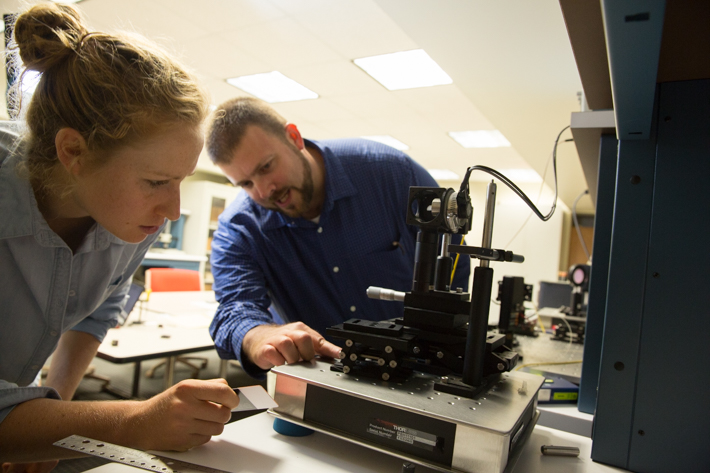When asked by a prospective student’s parent whether biomedical engineering was simply a “fad,” Professor Jason Zara was pointed in his response: “Well, do you want to die any time soon?”
Better health and a desire to live longer, he said, are never going out of style.
Recognizing how rapidly the field is growing, the George Washington University School of Engineering and Applied Science (SEAS) launched the Department of Biomedical Engineering (BME) this fall. With the new department also comes the addition of a Ph.D. program in BME. Dr. Zara, who helped develop GW’s undergraduate biomedical engineering program in 2002, serves as the department’s interim chair.
Biomedical engineers are the masterminds behind technologies that are changing modern medicine as we know it. Researchers at GW, for example, are improving heart disease therapies, developing imaging instruments to detect cancers and building handheld medical diagnostic devices.
Employment of biomedical engineers is projected to grow 27 percent from 2012 to 2022, according to the Bureau of Labor Statistics. CNN Money named biomedical engineer the “Best Job in America” in 2012 and 2013.
“Particularly with an aging population, there is great need for better, more efficient and cost-effective health care. Biomedical engineering directly addresses those issues,” said Dr. Zara, an associate professor of biomedical engineering.
Elevating Research
Though BME is one of the most popular undergraduate majors in SEAS—with an average of 50 to 60 students per class—it was the only engineering major that did not previously have a department with its own name. The bachelor’s and master’s degree programs formerly were housed within the Department of Electrical and Computer Engineering (ECE).
Having a separate department not only will give GW’s BME degree programs greater national visibility, but it will also help attract world-class faculty and build upon the school’s research program, said Matthew Kay, an associate professor of biomedical engineering.
The BME department currently has five full-time faculty members. The department hopes to at least double that number within the next five years and to hire a department chair by 2015, Dr. Kay said.
“We want to bring faculty members to the team who will have new expertise in order to broaden the scope of our coursework into new areas of engineering and medicine, as well as to open up areas of research that we are not currently exploring,” Dr. Kay said.
Further, the interdisciplinary nature of biomedical engineering will also magnify the excellence of research, not only in the BME department, but also throughout SEAS and across GW, according to SEAS Dean David Dolling.
As the department grows, Dr. Dolling said he expects that more engineering faculty will add biomedical applications to their research portfolios, and more medical faculty will want to strengthen their programs by adding technical aspects.
“We believe that a flourishing BME department will serve as a vibrant hub for interdisciplinary research and education,” Dr. Dolling said.
Encouraging Collaboration
Now is an ideal time to launch a biomedical engineering department at GW.
The 2015 opening of the Science and Engineering Hall on the Foggy Bottom Campus will provide researchers and students with laboratory space and state-of-the-art, core facilities, such as a biomedical imaging lab. In addition, the building—which will also house faculty from the Columbian College of Arts and Sciences, the School of Medicine and Health Sciences and the Milken Institute School of Public Health—is located directly across from GW Hospital. Since biomedical engineering is interdisciplinary by design, collaboration between doctors and researchers from other disciplines is critical, Dr. Zara said.
“You cannot just build something in the lab and hope it works,” he said. “You need to be talking to and collaborating with clinicians throughout the process.”
In addition, GW’s proximity to renowned research centers gives students an added edge.
“Being a Metro ride away from the National Institutes of Health and an easy drive to the Food and Drug Administration puts GW BME in a very unique position compared to other biomedical engineering departments around the country,” Dr. Zara said.
Students are often attracted to the major, Dr. Zara noted, because it allows them to combine their interests in math and physics with biology and physiology. And while undergraduates in the biomedical engineering program have the option to specialize in a specific field, such as biomechanics, the degree gives students a broad skillset. Graduates from GW’s biomedical engineering programs have gone on to work in industry, hospitals and research labs. Others are dentists, doctors and veterinarians, Dr. Zara said.
When Sarah Pickus came to GW four years ago, she chose biomedical engineering as a major with plans to apply to medical school. But after taking medical imaging courses with Dr. Zara, she decided to change her focus and apply to the Ph.D. programs in engineering.
She was ecstatic to find out that GW would offer a Ph.D. program in biomedical engineering in the fall, and she said she is looking forward to being a part of a program that is new.
“There is something to be said about being a part of a program that is going through these watershed moments,” Ms. Pickus said. “I was accepted into other programs that were more established and may have been the safer choice, but staying at GW is going to be more rewarding in the end.”


